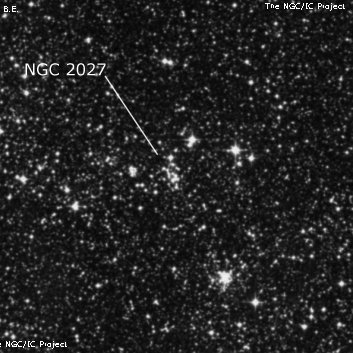
NGC 2027 is situated ~10' NW of the compact cluster NGC 2041 and near the east end of a huge, elongated star cloud known as the "Quadrant" (consisting of OB associations LH 65, LH 77 and LH 84) looping SW and the bending NW, extending 35' to NGC 2006 and 2002.
James Dunlop discovered NGC 2027 = D 241 = h2908 on 6 Nov 1826 and described "a large cluster of small stars of mixt magnitudes in strong nebula; irregular extended figure." His position falls at the east end of association LH 77 or the west end of LH 84, known as the LMC "Quadrant" (of a circle).
JH made three observations of the field. On the first sweep (2 Nov 1832) he described "a very large, very rich cluster of separate stars 9..11th mag, which fills the whole field." On a second sweep he called it "cluster 7th class. The second of two stars 9th mag, which may be considered the leading stars of the very large and fine cluster of the Nubecula Major, which fills many fields, is of all degrees of condensation, and much broken up into groups and patches." His third observation was recorded as "an ill-defined nebuloid group of stars 15th mag (N.B. Clouds very troublesome.) The field full of grouping stars."
Herschel is clearly describing the large OB association LH 77, which stretches west to NGC 2002. His position from the second sweep ("second of two stars 9th magnitude") and third sweeps is close to S-L 592, and the position given here. This cluster is also at the west end of a looping association of stars (probably NGC 2027) on the east end of LH 77.
300/350mm - 13.1" (2/20/04 - Costa Rica): NGC 2027 is at the west end of an interesting, elongated cluster or association (LH 84) extending ~4'x2' E-W in a crescent shape with NGC 2034 at the east end. At 105x, this condensed portion of the cloud contains a couple of dozen mag 12-13 stars and a wide pair of mag 10 stars on the NW side. Although NGC 2027 is often applied to the small cluster S-L 592, Herschel described the entire association LH 84.
Notes by Steve Gottlieb